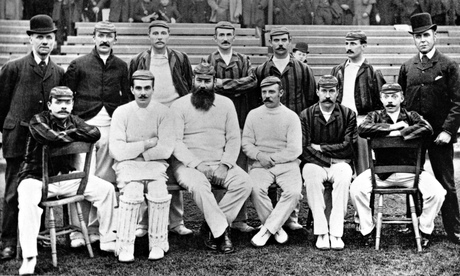David Foster Wallace was, in his own estimation, “a near great junior tennis player”. Between the ages of 12 and 15, he competed in tournaments all over the Midwest, at one point achieving a regional ranking of 17. He wrote about the experience in “Derivative Sport in Tornado Alley”, the first – and most challenging – of the five essays in this volume. “Derivative Sport” is unlike any other sporting memoir you’ll encounter: it combines a (somewhat sketchy) account of life on the junior circuit with voluminous divagations into climate, topography and geometry. Wallace’s aim appears to be to demonstrate that his success on the tennis court was largely accidental – less a reward for talent and perseverance than the unforeseeable outcome of freakish circumstance.
Because of where he grew up – the Illinois Corn Belt – Wallace felt at home “inside vectors, lines and lines athwart lines, grids”. A certain “weird proclivity for intuitive math” meant, moreover, that he found the “geometric thinking” required by tennis (all those rapid trigonometric calculations) straightforward. And most crucially, unlike practically every other player on the planet, he relished playing in the wind. (This, too, he links to his mathematical prowess: “I could … admit the differential complication of wind into my calculations.”) Being at ease with the wind gave Wallace a tremendous advantage, since he grew up in a pocket of Illinois known as Tornado Alley. The wind, he writes, “informed and deformed” life in his hometown, and did “massive damage to many central Illinois junior players”. Yet Wallace was able to cultivate a “robotic detachment” from his environment, and so spent his youth “beating up on” more naturally gifted players. Facing him – especially in a howling gale – must have been a nightmare.
But Wallace’s success was necessarily shortlived. As he got older and better, he started competing in more prestigious tournaments. At such events (“into which my rural excellence was an easement”), he encountered conditions less favourable to his game. As he puts it: “Once I hit a certain level of tournament facilities, I was disabled because I was unable to accommodate the absence of disabilities to accommodate.” And so his career flatlined. Players he’d once outwitted now out-bludgeoned him. At Amherst, the small east-coast college he started attending in 1980, he barely made the team.
Though Wallace claims that the decline of his tennis fortunes provided him with his first taste of “true adult sadness”, one senses, reading the essay, that he wasn’t too cut up about it. The truth – which he all too obviously grasps – is that he was constitutionally unsuited to life as an athlete. There was too much else going on in his overdeveloped brain. Yet exactly what remains unknowable. “Derivative Sport”, a piece about sneakily achieved athletic success, is itself an artfully sneaky (and entirely captivating) piece of writing. Under the guise of being modest, Wallace is actually being slyly boastful (I alone was clever enough to capitalise on my environment), while also revealing very little of himself. What the essay does make abundantly clear, though, is that tennis, at least as a sport to play, couldn’t bear the weight of Wallace’s over-intellectualising tendencies. He may, for a while, have felt at home within lines and grids; but when he got older, they stopped being able to contain him.
And so Wallace quit tennis. But he never turned his back on the sport. For the remainder of his life, it continued to fascinate him – and he returned to it regularly in writing. Infinite Jest, his 1996 magnum opus, is set partly in a tennis academy, and deals with the life – does this sound familiar? – of a preternaturally intelligent tennis prodigy. The sport, moreover, inspired some of his finest non-fiction: most famously his 2006 piece about Roger Federer, which would become (along with “Consider the Lobster” and “A Supposedly Fun Thing I’ll Never Do Again”) one of his best-known essays; but also a handful of earlier pieces, written for various US magazines. Now, for the first time, these have been gathered in a single volume, with an elegant introduction by John Jeremiah Sullivan.
Read together, these pieces demonstrate a few things. One is that Wallace’s grasp of tennis was truly prodigious. The analytical powers that must have ended up hindering him as a player made him a peerless observer of the sport. He has often been described as the best tennis writer of all time, and these essays don’t disabuse that notion. Wallace is interested in – and understands – every aspect of the game, from its strategic complications and technical evolution through to sponsorship deals and methods of hydration. In itself, of course, such knowledge isn’t exceptional. But where Wallace stands apart is that he is never boring with it. One of the marvels of his writing is the way it combines a nerd’s outlook with a novelist’s gift for exposition. And so when you read, say, the third essay in this book – a 12,000-word screed on the long-forgotten American journeyman Michael Joyce – you don’t begrudge the need to break off from the narrative to take in a half-page footnote on the politics of players’ appearance fees.
Something else about tennis clearly attracted Wallace: the opportunity it gave him to ruminate on excellence. His interest in this topic was by no means impersonal: his life, after all, was devoted to its pursuit. Four of the five essays here are about what it means to be great – or nearly great – on a tennis court. (The fifth, “Democracy and Commerce at the US Open”, avoids the subject, and is to my mind the only dud in the pack.) Wallace approaches greatness from a variety of angles. “How Tracey Austin Broke My Heart”, a review of the American player’s 1992 memoir Beyond Center Court, explores its psychology. Why, Wallace wants to know, are top athletes so uniformly unenlightening about their achievements, when they are the only people who actually know what it feels like to be so mind-bogglingly good? Wallace answers his own question (and lets Austin et al off the hook) by introducing a typically ingenious paradox: it “may well be”, he says, that only those who aren’t divinely gifted as athletes (ie spectators) are capable of seeing and articulating sporting genius, while those who actually “receive and act out the gift” must necessarily be “blind and dumb about it – and not because blindness and dumbness are the price of the gift, but because they are its essence”.
In his essay on Michael Joyce (“as of this day the 79th best tennis player on planet Earth”), Wallace considers the workaday life of someone who, though outstanding at what he does, will never be a household name. The essay is a lovely, lolling thing, circling around its subject without reaching any firm conclusions, but allowing Wallace to indulge his omnivorous interest in the sport. Readers (like me) who come to it after the Federer essay might find some of its arguments – particularly those that deal with the development of the “power-baseline game” – familiar, but this doesn’t matter: it’s a pleasure to encounter them in their earlier incarnations. The Federer essay, by contrast, is a much more urgent piece of writing, and that’s because, this time, Wallace’s arguments do sharpen to a point: the essay ends with the suggestion that Federer has, “literally and figuratively, re-embodied men’s tennis” – in other words, has shown that the sport hadn’t reached its “evolutionary endpoint”. I don’t think it’s fanciful to imagine that, in suggesting this, Wallace was also thinking of his own writing, and his need to find a way out of the creative impasse that trying to complete his final novel, The Pale King, had produced. The sad thing is that he never did find a way out. Within two years of writing the essay, he was dead.
• To order String Theory for £12 (RRP £15) go to bookshop.theguardian.com or call 0330 333 6846. Free UK p&p over £15, online orders only. Phone orders min p&p of £1.99.











